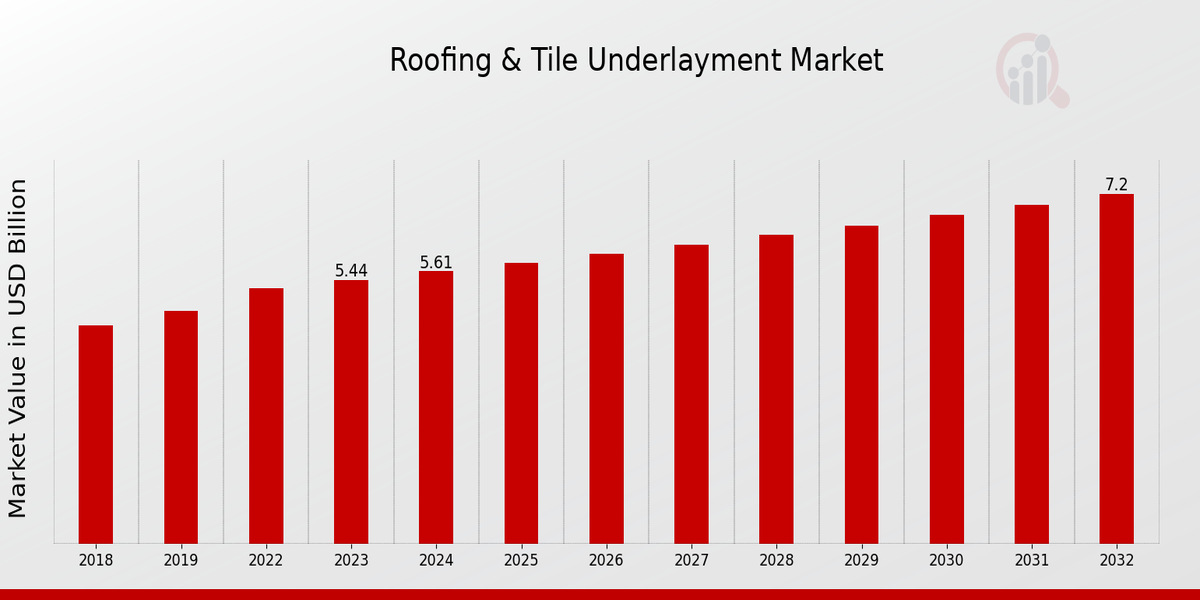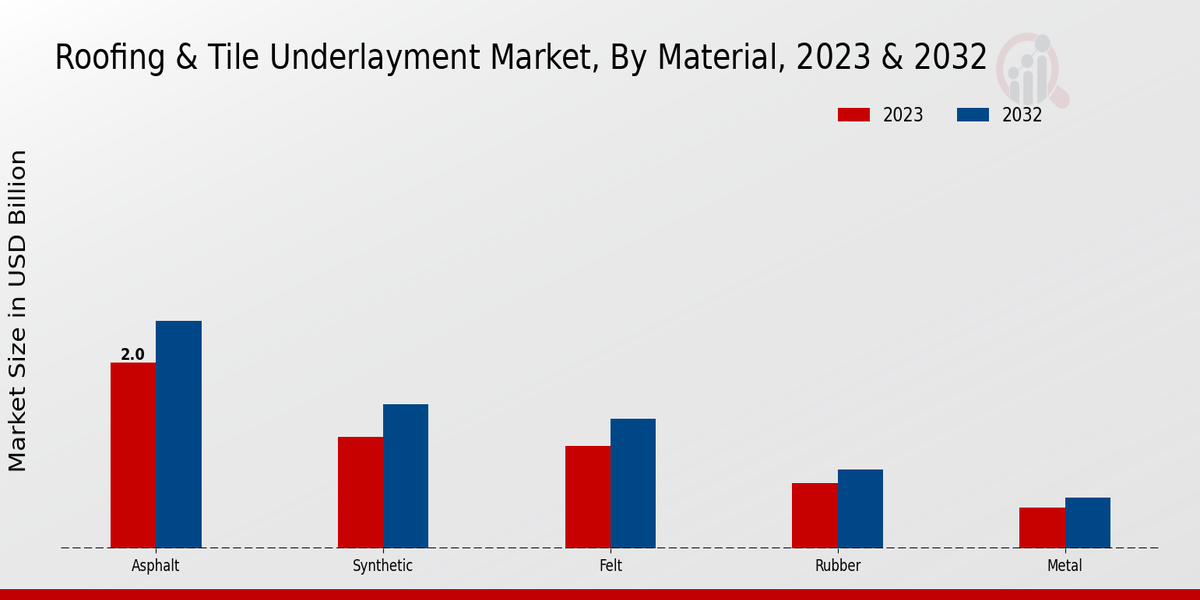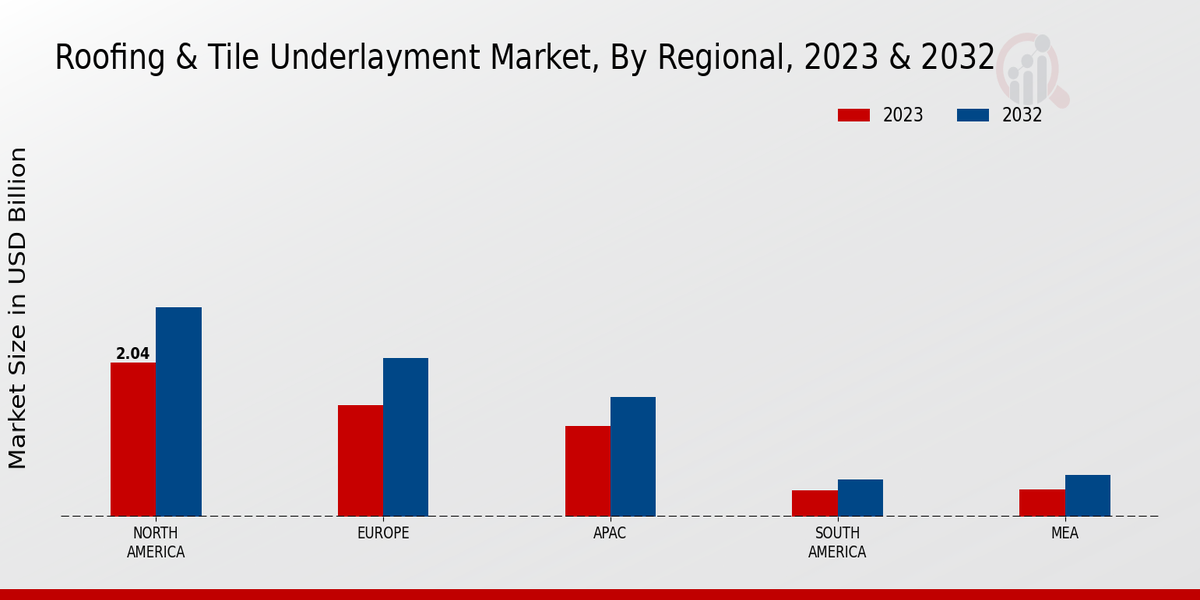Global Roofing Tile Underlayment Market Overview
The Roofing Tile Underlayment Market Size was estimated at 5.79 (USD Billion) in 2024. The Roofing Tile Underlayment Industry is expected to grow from 5.97(USD Billion) in 2025 to 7.91 (USD Billion) by 2034. The Roofing Tile Underlayment Market CAGR (growth rate) is expected to be around 3.2% during the forecast period (2025 - 2034).
Key Roofing Tile Underlayment Market Trends Highlighted
The Roofing Tile Underlayment Market is on the rise owing to key factors. One of the key factors is the increase in the need for roofing materials that are of high quality and have a long lifespan. As builders and homeowners aim to build such structures, their need for these products must be met. The increasing number of construction activities in developing countries is also a key aspect in driving this industry forward. Also, due to the increased demand for energy-efficient features, manufacturers invest time and resources in making technologically advanced, underlayment products that improve insulation and are cost effective. These innovations are appealing to consumers who are conscious of the environment and are a factor for the growth of the market.
The roofing and tile underlayment segments have lots of opportunities. More advanced materials that can provide better performance and more leak and moisture protection are in strong demand. Companies can take advantage of such market trends by extending their range to green products. In addition, the increased interest in green construction certificates provides ways for manufacturers, contractors, and builders to cooperate and innovate. The renovation market is also worth exploring as many homeowners are now willing to change roofs to make new and sophisticated designed roofs.
The construction industry does not stay still but flows along with new developments and changes. One of the most pursued novel trends is the utilization of lightweight materials – they are easier to fit than heavy options and reduce the load imposed on structures. In addition, the digitalization of construction activities facilitates improvements in the organization and management of the processes, which in turn may enhance the penetration of roofing products. There is an increasing trend towards the enhancement of the aforementioned features, such as improvement of the water proofing ability of the roofs and the fire resistance of the materials been used. With the verticals of standards becoming more rigorous manufacturers have to move with the changes to remain within the standards whilst still providing quality and performance.
Generally speaking, the market is expected to keep changing as it accommodates the changes in taste of the customers as well as the environmental issues.

Source: Primary Research, Secondary Research, MRFR Database and Analyst Review
Roofing Tile Underlayment Market Drivers
Growing Demand for Energy-Efficient Building Materials
The increased emphasis on sustainable construction has greatly influenced the Roofing Tile Underlayment Market Industry, leading to a surge in demand for energy-efficient building materials. As governments and environmental organizations push for stricter regulations on energy consumption and emissions, builders and contractors are more inclined to invest in roofing systems that improve energy efficiency. Tile underlayment products often contribute significantly to a building's thermal performance, thereby enhancing overall energy savings.The Roofing Tile Underlayment Market industry is progressing rapidly as roofing solutions increasingly integrate advanced materials technology designed to mitigate heat transfer and water infiltration. Consumers today are more environmentally conscious and are actively seeking roofing materials that optimize energy efficiency while maintaining durability and aesthetics. Additionally, the long-term savings on energy costs make these products an attractive option for both residential and commercial projects.As urbanization continues and the construction sector grows, the demand for energy-efficient roofing solutions will help to solidify the growth trajectory of the Roofing Tile Underlayment Market.
Expansion of Construction Activities
The resurgence in construction activities across various markets directly fuels the Roofing Tile Underlayment Market industry. Increased urbanization and population growth have perpetuated a robust demand for residential and commercial buildings. With more structures being erected, the need for quality roofing and appropriate underlayment solutions becomes paramount. This rising construction wave, coupled with ongoing infrastructure projects aimed at enhancing city landscapes, solidifies the necessity for effective roofing systems.As new building codes and standards are implemented, builders are also more inclined to select premium underlayment products that comply with these regulations, driving further growth in the market.
Technological Advancements in Underlayment Materials
Rapid technological advancements in roofing underlayment materials significantly contribute to the growth of the Roofing Tile Underlayment Market. Manufacturers are increasingly investing in research and development to create innovative underlayment products that offer enhanced performance, durability, and ease of installation. The introduction of synthetic underlayment, for example, provides improved moisture protection, tear resistance, and UV stability compared to traditional felt products.These advancements not only contribute to better roofing systems but also raise consumer awareness of the benefits associated with high-quality underlayment. As more builders recognize the advantages of utilizing cutting-edge materials, the market is poised for expansion, spurred by evolving construction trends and consumer demands.
Roofing Tile Underlayment Market Segment Insights:
Roofing Tile Underlayment Market Material Insights
The Roofing Tile Underlayment Market, particularly focusing on the Material segment, demonstrates a robust structure and significant growth potential. This market is projected to see continued momentum, with a total estimated revenue of 5.44 USD Billion in 2023, growing to 7.2 USD Billion by 2032. This growth is driven by an increasing demand for high-quality roofing solutions that provide durability and protection. The market is segmented into multiple materials, including Asphalt, Synthetic, Felt, Rubber, and Metal, each contributing uniquely to the overall landscape.Asphalt, with a valuation of 2.0 USD Billion in 2023, takes the lead in this market due to its widespread use and reliability, dominating the segment with a majority holding. This material is preferred for its cost-effectiveness and excellent waterproofing properties, making it a favorite among contractors and builders alike. Following closely is the Synthetic category, valued at 1.2 USD Billion in 2023, which is gaining traction due to its lightweight nature and superior performance characteristics. Synthetic materials often outperform traditional options in terms of longevity and resistance to extreme weather conditions, thereby presenting significant opportunities for growth in the coming years.The Felt segment, standing at 1.1 USD Billion, remains a traditional choice amongst users looking for a cost-effective solution, although it faces stiff competition from newer materials. Rubber, valued at 0.7 USD Billion, is also making inroads as it offers excellent flexibility and resistance to UV rays, appealing to eco-conscious consumers. Meanwhile, the Metal segment, valued at 0.44 USD Billion, is gaining attention for its longevity and resistance to corrosion, making it an attractive option for both residential and commercial applications.The overall Roofing Tile Underlayment Market statistics show a diverse arena with each material vying for a position, shaped by consumer preferences, environmental considerations, and technological advancements that influence purchasing decisions. Understanding the dynamics and drivers behind these segments is crucial as they play an essential role in determining future market growth and opportunities.

Source: Primary Research, Secondary Research, MRFR Database and Analyst Review
Roofing Tile Underlayment Market Type Insights
The Roofing Tile Underlayment Market is projected to reach a valuation of 5.44 USD Billion in 2023, driven by increasing demand for protective layers in roofing applications. Among the different types, waterproof underlayment plays a crucial role due to its ability to provide complete moisture protection, which is vital in regions prone to heavy rainfall. Water-resistant options are also significant, catering to properties that experience moderate exposure to moisture, making them attractive to homeowners seeking balance between cost and protection.Furthermore, breathable underlayment is gaining traction, particularly in environments requiring ventilation, as it allows moisture control while protecting the roofing structure. Non-breathable underlayment, while facing competitive pressure, remains relevant for its straightforward application in less moisture-sensitive designs. In this context, understanding the Roofing Tile Underlayment Market data helps identify evolving consumer preferences and enhances market growth opportunities. The segment's importance reflects a broader trend towards enhanced construction materials that improve building longevity and performance, contributing to the overall Roofing Tile Underlayment Market industry landscape.
Roofing Tile Underlayment Market Application Insights
The Roofing Tile Underlayment Market, with a market value of 5.44 USD Billion in 2023, shows significant opportunity across diverse applications. The application segment includes Residential, Commercial, Industrial, and Institutional sectors, each contributing to the overall market dynamics. The Residential segment plays a crucial role as it addresses the growing demand for durable roofing systems in homes, while the Commercial segment is marked by substantial investments in infrastructure and property development projects, driving the need for reliable underlayment solutions.The Industrial application is characterized by the necessity of specialized roofing products to meet the rigorous demands of manufacturing facilities, whereas the Institutional segment is vital, with a focus on sustainable building solutions and long-term reliability in educational and healthcare facilities. Collectively, these sectors underscore the importance of market growth, fueled by trends towards sustainability, energy efficiency, and advancements in roofing technology, positioning the Roofing Tile Underlayment Market for progressive expansion.Furthermore, it presents robust opportunities for innovation, despite facing challenges related to fluctuating raw material prices and regulatory compliances.
Roofing Tile Underlayment Market Product Form Insights
The Roofing Tile Underlayment Market, valued at 5.44 billion USD in 2023, shows a diversified Product Form segment that includes Rolls, Sheets, and Panels. Each of these forms plays a crucial role in the roofing industry. Rolls are particularly popular for their ease of installation and seamless coverage, which enhances waterproofing efficiency. Sheets offer superior durability and are often preferred for high-slope applications, contributing significantly to the market. Panels, while generally more costly, provide enhanced structural strength and are favored in high-performance roofing projects.As the market evolves, factors such as increased construction activities and the growing emphasis on energy efficiency drive demand for these forms. However, challenges such as fluctuating raw material costs may impact market dynamics. The projected market growth presents opportunities for innovation and expansion within each form, fostering advancements that meet changing consumer needs in the Roofing Tile Underlayment Market. The market statistics indicate a potential for significant revenue growth through 2032, providing a favorable outlook for all product forms in the roofing and tile underlayment segment.
Roofing Tile Underlayment Market Regional Insights
The Roofing Tile Underlayment Market, valued at 5.44 USD Billion in 2023, is set to experience robust growth across various regional sectors. North America holds a majority share, with a valuation of 2.04 USD Billion in 2023, expected to increase to 2.77 USD Billion by 2032. This region is significant due to its established construction industry and rising demand for durable building materials. Europe follows, valued at 1.48 USD Billion in 2023, projected to grow to 2.1 USD Billion by 2032, driven by increasing renovation projects and sustainability trends.The Asia-Pacific (APAC) market, valued at 1.2 USD Billion in 2023, is set to grow to 1.58 USD Billion by 2032, thanks to rapid urbanization and infrastructural development. South America and the Middle East Africa (MEA) are relatively smaller markets, with valuations of 0.35 USD Billion and 0.37 USD Billion in 2023, respectively, expected to rise to 0.5 USD Billion and 0.55 USD Billion by 2032. Though these regions hold lesser shares, their emerging markets present opportunities for growth in the Roofing Tile Underlayment Market. The diverse regional dynamics highlight emerging trends, growth drivers, and opportunities for market participants in optimizing their strategies to cater to the varying demands.

Source: Primary Research, Secondary Research, MRFR Database and Analyst Review
Roofing Tile Underlayment Market Key Players and Competitive Insights:
The Roofing Tile Underlayment Market is characterized by an evolving landscape of competition comprising established companies, innovative newcomers, and a range of product offerings. As construction trends shift towards higher durability and energy efficiency, roof underlayment materials have gained prominence as pivotal components in roofing systems. The market has seen a surge in demand driven by both residential and commercial sectors, leading to significant advancements in technology and material efficacy. Key players in this market are actively investing in research and development to enhance product performance and cater to diverse climatic requirements. The competitive dynamics are underpinned by factors such as pricing strategies, distribution networks, and regional availability, which shape the interactions among these industry participants.DuPont has carved a strong niche for itself in the Roofing Tile Underlayment Market, leveraging its extensive experience in materials science and innovation. The company is well-regarded for its high-performing products that ensure superior protection against water infiltration and moisture damage. DuPont's underlayment technologies are engineered to enhance the longevity of roofing systems, providing customers with peace of mind through durability and reliability. Their commitment to sustainability is evident in the development of eco-friendly solutions that minimize environmental impact while meeting rigorous performance standards. Additionally, DuPont's reach allows it to serve a diverse clientele effectively, enhancing its competitive position in various regional markets. The company consistently emphasizes quality control and robust testing protocols, which further establish its reputation as a trusted provider in the roofing sector.Firestone Building Products is another formidable player in the Roofing Tile Underlayment Market, recognized for its comprehensive range of roof underlayment solutions tailored for various applications. The company is known for its innovation in products that offer excellent waterproofing capabilities and sound reduction features, appealing to both residential builders and commercial contractors. Firestone's strong emphasis on customer service and technical support enhances its market presence and fosters long-term relationships with clients. By prioritizing research and development, Firestone continually improves its product offerings to meet the evolving needs of the market while ensuring compliance with industry standards. Their strategic partnerships and distribution networks further amplify their competitive edge, allowing for effective penetration into emerging markets. In response to the growing demand for sustainable building products, Firestone is also exploring ways to incorporate recycled materials into its underlayment solutions, aligning with the industry's shift towards environmental responsibility.
Key Companies in the Roofing Tile Underlayment Market Include:
Roofing Tile Underlayment Market Industry Developments
Recent developments in the Roofing Tile Underlayment Market have been marked by significant activities from major players such as DuPont, GAF, and Owens Corning, reflecting ongoing innovation and competition. In particular, GAF has launched new underlayment products designed to enhance water resistance, catering to the increasing demand for durable roofing solutions. There has also been a surge in eco-friendly products, with Sika AG and Atlas Roofing introducing sustainable materials aimed at reducing environmental impact. Merger and acquisition activity has been notable as well, with DuPont exploring strategic partnerships to expand its market reach. Atlas Roofing has been involved in discussions regarding potential acquisitions to diversify its product portfolio, which aligns with current trends in the industry seeking growth through consolidation. In addition, market valuations have shown a positive trajectory, driven by rising construction activities and an increased focus on roof performance, which continues to elevate the competitive landscape among companies like TAMKO Building Products and CertainTeed. As companies adapt to these trends, investments in research and development are gaining momentum, further influencing market dynamics in the roofing and tile underlayment sector.
Roofing Tile Underlayment Market Segmentation Insights
Roofing Tile Underlayment Market Material Outlook
-
Asphalt
-
Synthetic
-
Felt
-
Rubber
-
Metal
Roofing Tile Underlayment Market Type Outlook
-
Waterproof
-
Water-Resistant
-
Breathable
-
Non-Breathable
Roofing Tile Underlayment Market Application Outlook
-
Residential
-
Commercial
-
Industrial
-
Institutional
Roofing Tile Underlayment Market Product Form Outlook
Roofing Tile Underlayment Market Regional Outlook
-
North America
-
Europe
-
South America
-
Asia Pacific
-
Middle East and Africa
| Report Attribute/Metric |
Details |
| Market Size 2024 |
5.79(USD Billion) |
| Market Size 2025 |
5.97(USD Billion) |
| Market Size 2034 |
7.91 (USD Billion) |
| Compound Annual Growth Rate (CAGR) |
3.2% (2025 - 2034) |
| Report Coverage |
Revenue Forecast, Competitive Landscape, Growth Factors, and Trends |
| Base Year |
2024 |
| Market Forecast Period |
2025 - 2034 |
| Historical Data |
2020 - 2024 |
| Market Forecast Units |
USD Billion |
| Key Companies Profiled |
DuPont, Firestone Building Products, Sika AG, Atlas Roofing, CertainTeed, TAMKO Building Products, GAF, Malarkey Roofing Products, MFM Building Products, Owens Corning, WrapOn Company, Tyvek, Bostik, IKO Industries, Polyglass |
| Segments Covered |
Material, Type, Application, Product Form, Regional |
| Key Market Opportunities |
Rising construction activities globally, Increasing demand for sustainable materials, Technological advancements in underlayment, Growth in residential renovation projects, Expansion in emerging markets. |
| Key Market Dynamics |
increasing construction activities, rising demand for energy efficiency, stringent building regulations, technological advancements in materials, growing awareness of waterproofing solutions |
| Countries Covered |
North America, Europe, APAC, South America, MEA |
Frequently Asked Questions (FAQ) :
The market is expected to be valued at 7.91USD Billion in 2034.
The expected CAGR for the market during this period is 3.2%.
North America is expected to hold the largest market share, valued at 2.77 USD Billion in 2032.
The Asphalt segment is projected to be valued at 2.45 USD Billion in 2032.
Major players include DuPont, Firestone Building Products, Sika AG, and Owens Corning among others.
The Felt material segment is anticipated to be valued at 1.4 USD Billion in 2032.
The APAC region is expected to be valued at 1.58 USD Billion in 2032.
The Synthetic underlayment is projected to reach 1.55 USD Billion in 2032.
Challenges include fluctuating raw material prices and increasing environmental regulations.
The South America region is expected to reach a market value of 0.5 USD Billion in 2032.

















